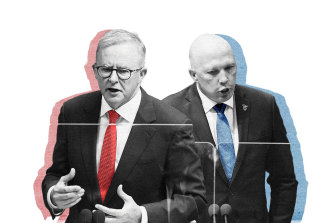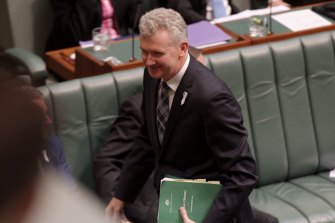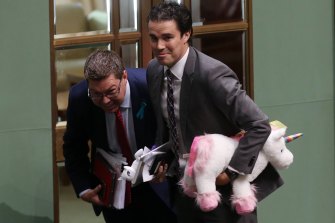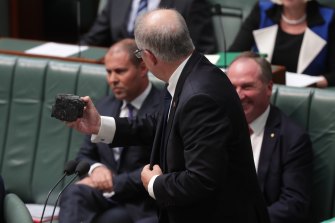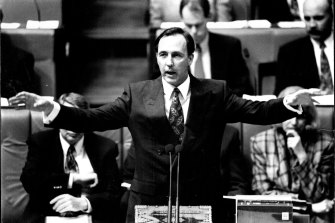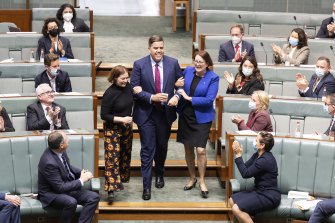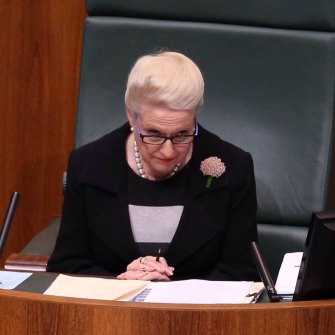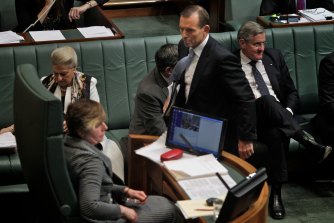Why can’t anyone get an answer in question time?

The prime minister wants to lift the tone of debate in parliament. How will MPs manage this in the most unruly hour of the day?
Worse than schoolyard antics. A farce. A waste of time. The public perception of parliament is largely shaped by what happens during question time. It’s a small fraction of the day, but the high-profile, nationally televised debate is regularly mined for snappy lines that can make the evening news.
Yet to many observers, it is the most raucous and unruly part of parliament.
Prime Minister Anthony Albanese has repeatedly said he wants to “do politics differently” and lift the tone of debate in parliament. “It starts with giving people respect,” he says. “It requires, of course, the co-operation of all members of parliament. But I’m very confident that we can have a much better functioning parliament.”
So, what will change with question time? And how does it work?
Credit:
What are the rules for question time?
Like everything that happens in parliament, question time is governed by both actual rules and conventions arising from the Westminster tradition.
The rules are known as the standing orders, and a good parliamentary tactician will know all of their (sometimes arcane) ins and outs off the top of their head. For the rest of us, there’s the 1000-plus page House of Representatives Practice. This tome unpacks the conventions around how the lower house operates, the precedents for rulings or ways things are done, and its history. The leader of the House (Tony Burke) and manager of opposition business (the frontbencher from each side in charge of tactics and running parliament, currently Paul Fletcher) will usually have a well-thumbed, heavily bookmarked copy of this somewhere close to hand, ready to jump up and contest a Speaker’s ruling or explain why the thing they want to do really is the correct way.
Questions are now limited to 30 seconds – although crossbenchers are allowed 45 seconds, in what is colloquially known as the Bob Katter rule.
While the rules have evolved over the 121 years since federation, the shape of how things operate in the modern parliament was struck in the “group hug” moment after the 2010 election when Julia Gillard had to make a deal with the Greens and independents to hold power in the minority parliament. As a result of that deal, there were guaranteed questions for the crossbench during question time and a dedicated period set aside each sitting week for private members’ business (that means for any MP other than the prime minister, Speaker, minister or assistant minister) because the government controls what business is dealt with in the lower house.
Broadly speaking, the running of question time is at the discretion of the prime minister and the Speaker of the House. The prime minister gets to set the length and the Speaker sets the tone.
These days, there are usually about 20 questions per session. This has increased slowly over time. In 1993, the then-government agreed there should be a minimum of 14 questions each day after the average number per session dropped from 16 in the 1970s to 12. That means a typical question time runs for about 70 minutes, from 2pm until a little after 3pm.
Questions are now limited to 30 seconds, although crossbenchers are allowed 45 seconds, in what is colloquially known as the “Bob Katter rule” because the verbose member for Kennedy can rarely fit his query into 30 seconds.
Since 2010, answers have also been given time limits, currently at three minutes. Before then, ministers could speak for as long as they liked – and often did.
There are also plenty of rules about what can be asked.
Tony Burke, then-manager of opposition business, is ejected from the House by speaker Bronwyn Bishop during question time in 2014. Credit:Andrew Meares
Questions can’t be hypothetical. They can’t contain arguments or insults. They can’t be about a minister’s former portfolio, only the one they currently hold. They can’t be something already “fully answered”.
If you’re a regular viewer of question time, you will be unsurprised to learn there aren’t so many rules about answers.
Even for the most narrowly focused question … no one can tell the minister they must offer either a “yes” or “no” and sit down.
In fact, it’s a long-established practice that ministers cannot be required to answer questions at all. Even for the most narrowly focused question that one would think would elicit a “yes” or “no” answer, no one can tell the minister they must offer either a “yes” or “no” and sit down.
The main rule for answers is they’re supposed to be relevant to the question. However, it depends on the Speaker how much leeway is given and, as Reps Practice puts it, “the interpretation of ‘relevant’ has at times been very wide”.
Highly regarded Speaker Tony Smith, who presided over the House from 2015 to 2021 before retiring in May, took a narrow interpretation of relevancy and regularly cut short ministers – and, on occasion, the prime minister – if they didn’t heed his warnings to stick to the topic at hand.
Pat Conroy (left) and Tim Watts bow to the Speaker after being ejected for displaying unicorn props in question time in 2016.Credit:Andrew Meares
If there are all these rules, why is question time so rowdy?
Question time is really the most unstructured part of the parliamentary day. The government can only control the questions its side asks, and it gives the opposition a chance to pursue its attacks or agenda. This means question time has evolved into a theatrical set piece of parliament as well as a key way of holding the executive to account.
“It’s a small snapshot of the combat that underlines two-party politics in Australia,” says veteran Age and SMH political journalist Tony Wright. “Question time is also a place to see how well a government is weathering a storm and how fit it is – and conversely, it’s also a test of the opposition’s fitness. It’s theatrical, but a lot of politics is theatre.”
He says question time shines when a government is under serious pressure, such as when Paul Keating-era minister Ros Kelly came under sustained questioning over the original “sports rorts” saga when she had used a giant whiteboard to allocate grant funding.
Props are technically banned but you will sometimes get frontbenchers “accidentally” waving around a large-print graph or newspaper article that underlines their point. One of the best-known props in recent history was the lump of coal that former prime minister and then-treasurer Scott Morrison held up in the chamber, saying: “This is coal. Don’t be afraid, don’t be scared.”
Then-treasurer Scott Morrison with a lump of coal during question time in 2017.Credit:Fairfax
Question time is usually the best-attended part of the sitting day too – by politicians, media and the public – giving ministers and opposition MPs a large audience for whom they can perform.
But Wright says the whole affair has become much worse since questions started being televised in the ’90s, fulfilling Paul Keating’s fears the broadcast of proceedings would lower the tone of parliament and increase the public’s cynicism about politics.
“He didn’t want to give the opposition a free kick and didn’t want the public to be confronted with what it’s really like, the rolling aggression,” Wright says of Keating’s objections.
Former prime minister Paul Keating, shown here in 1992, didn’t want question time to be televised. Credit:Palani Mohan
Still, Keating is now famous for his parliamentary performances, especially his answer to opposition leader John Hewson’s question, “Why will you not call an early election?” Keating replied: “The answer is, mate, because I want to do you slowly.”
What happens if you break the rules?
The Speaker has a range of escalating powers to deal with unruly MPs. These start with issuing a warning to an MP, basically a polite way of telling them to shut up and stop interjecting. If they continue, the Speaker can eject them under the standing order 94(a), which is effectively an hour-long sin bin.
Nick Champion holds the dubious record of having been given the most hour-long suspensions from the chamber, notching up 100 of them.
Liberal Bronwyn Bishop was a notorious user of this rule, on one occasion kicking out 18 Labor MPs in a single session of question time. Labor’s Nick Champion holds the dubious record of having been given the most hour-long suspensions from the chamber, notching up 100 of them.
The next level up is “naming” a member, which means the House votes to suspend them from the chamber for a period, usually 24 hours. This is used, for example, if an MP continues to shout while they are leaving the chamber under 94(a), or otherwise grossly defies a Speaker’s ruling.
The Senate has its own set of standing orders, but the Senate president doesn’t have the power to sin-bin rowdy senators.
Oxley MP Milton Dick is “dragged” to the Speaker’s chair – as is the tradition – after his election to the role in July.Credit:Alex Ellinghausen
What will change in the new parliament?
The main concrete change to question time this year will be the crossbenchers being guaranteed three questions each session. The government has agreed to this change in recognition that the crossbench has doubled in size, up from seven MPs to 16.
Burke has also promised a change to “the demeanour of the government” in its approach to question time. “We got to the point [in the last parliament] where 15 seconds into a question, ministers had had enough talking about their own policy and were just sledging for the rest of the question,” he told ABC’s Insiders the week before parliament returned. “Ministers and governments determine the respect they’re willing to show for the parliament.”
I want to see question time be able to occur without seeing significant disruption.
Albanese – who was leader of the House during the Gillard minority government and had to deal with former prime minister Tony Abbott’s highly disruptive parliamentary tactics – has made it clear he wants to see parliament operating smoothly and with all sides offering respect.
“I want to see question time be able to occur without seeing significant disruption that we’ve seen. I want parliament to be able to legislate properly and I want it to function much better,” he said recently.
“Governments can set the agenda … but I’m very confident that we can have a much better functioning parliament.”
What else could change at question time?
A parliamentary committee considered how and why question time had reached its current state – and had come to be held in such low public esteem – in a thorough report tabled in March 2021. It made 11 recommendations, including tighter time limits on questions and answers, restrictions on when points of order (interruptions to argue about procedure) can be made and when the prime minister can pass questions on to another minister (a common practice of Morrison, in particular).
One of its key recommendations was to cut down on the number of “Dorothy Dixers” and replace them with opportunities for backbenchers to ask genuine constituency questions.
As Speaker, Bronwyn Bishop once ejected 18 MPs in one question time.Credit:Andrew Meares
What’s a Dorothy Dixer?
These are questions asked by government backbenchers of ministers that are either blatant opportunities to spruik government policy or blatant opportunities to sledge the opposition. Or both.
My question is to the minister for iced delicacies. Will the minister tell the House what the government is doing to facilitate the eating of ice-cream?
A common construction of them runs along the lines of: “My question is to the minister for iced delicacies. Will the minister tell the House what the government is doing to facilitate the eating of ice-cream? Is the minister aware of any alternative policies?”
This key phrase “alternative policies” would allow the minister to speak about how the opposition wants to take ice-creams from children while remaining relevant to the question.
The question format is named after popular advice columnist Dorothy Dix, who was rumoured to write her own questions.
Many political observers say scrapping Dixers would be the best way to improve question time.
Wright believes they’re getting more blatant and just allow ministers to take up half the time spouting government talking points without contributing much to political debate or knowledge.
“It’s supposed to be ‘questions without notice’ – they are not without notice on the government’s side, ever, and it becomes so absurd from time to time that a backbencher will stand up and read the wrong question to the wrong minister and have to start again,” he says.
Above: Backbencher Rowan Ramsey asks the wrong question.
But the government doesn’t want to do that, although Burke acknowledges these questions can be “not what some would regard as the ideal”.
“The questions from our own side, I mean you’ll judge what they’re like when you’re watching them,” he said.
“We’re not going to create a situation where the government agenda isn’t part of question time. Of course it will be. We’re not going to create a situation where the opposition and the crossbench are the only people to determine what the issues of the day are.”
Then-opposition leader Tony Abbott leaves the House after being ejected for an hour by deputy Speaker Anna Burke (left) during question time in 2012. Credit:Andrew Meares
Does relevance matter?
As with question time, one of the most important rules on debate in parliament is that speeches have to be relevant to the matter at hand. There are a few exceptions, including the adjournment debate (speeches given at the end of the sitting day, which can be on any topic) and members’ statements – often used to mention constituent matters or raise issues that an MP strongly believes in.
In the weeks following the opening of a new parliament, you’ll also hear addresses “in reply to the governor-general’s speech”, which can be an opportunity to make longer remarks on pretty much any topic. This is also the opportunity for new members to make their first speech to parliament. In the House of Representatives, members aren’t allowed to contribute to debate at all before making their first speech. The rules are different for the Senate, where newcomers can contribute whenever they want, provided they preface their remarks with, “This is not my first speech.”
Certain words and phrases are deemed ‘unparliamentary’ and banned from the chamber.
MPs aren’t allowed to use offensive or disorderly language, not even in quotations (a favourite tactic of Coalition ministers under Tony Abbott was to try and sneak in some colourful unionist language into speeches about the CFMEU), nor can they make “reflections on members”, meaning suggesting another MP has an improper motive or bad character.
Certain words and phrases are deemed “unparliamentary” and banned from the chamber, most notably calling another MP a “liar”. They also have to call other members by their proper titles, such as the member for Cook or the minister for home affairs, rather than use their names.
There is also a standing order that allows a Speaker to stop an MP on the basis of “persistent irrelevance or tedious repetition”, although this latter ruling has only been used twice, in 1904 and 1978.
There aren’t any plans to change these rules. The government is relying more on its intention to lead by example to restore a higher tone of debate.
The public can now judge whether that is successful.
Cut through the noise of federal politics with news, views and expert analysis from Jacqueline Maley. Subscribers can sign up to our weekly Inside Politics newsletter here.
Fascinating answers to perplexing questions delivered to your inbox every week. Sign up to get our new Explainer newsletter here.
If you'd like some expert background on an issue or a news event, drop us a line at [email protected] or [email protected]. Read more explainers here.
Most Viewed in Politics
Source: Read Full Article
